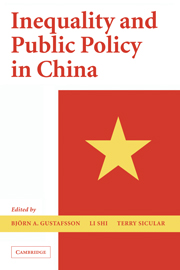Book contents
- Frontmatter
- Contents
- List of Tables and Figures
- Contributors
- Acknowledgments
- 1 Inequality and Public Policy in China: Issues and Trends
- 2 Income Inequality and Spatial Differences in China, 1988, 1995, and 2002
- 3 Growth and Distribution of Household Income in China between 1995 and 2002
- 4 Explaining Incomes and Inequality in China
- 5 The Distribution of Wealth in China
- 6 Growth, Inequality, and Poverty: A Comparative Study of China's Experience in the Periods before and after the Asian Crisis
- 7 What Has Economic Transition Meant for the Well-Being of the Elderly in China?
- 8 Inequity in Financing China's Health Care
- 9 China's Emerging Urban Wage Structure, 1995–2002
- 10 Unemployment, Earlier Retirement, and Changes in the Gender Income Gap in Urban China, 1995–2002
- 11 What Determines Living Arrangements of the Elderly in Urban China?
- 12 The Impact of Village-Specific Factors on Household Income in Rural China
- 13 The Redistributive Impact of Taxation in Rural China, 1995–2002: An Evaluation of Rural Taxation Reform at the Turn of the Century
- Appendix: The 1995 and 2002 Household Surveys: Sampling Methods and Data Description
- Index
- References
6 - Growth, Inequality, and Poverty: A Comparative Study of China's Experience in the Periods before and after the Asian Crisis
Published online by Cambridge University Press: 25 July 2009
- Frontmatter
- Contents
- List of Tables and Figures
- Contributors
- Acknowledgments
- 1 Inequality and Public Policy in China: Issues and Trends
- 2 Income Inequality and Spatial Differences in China, 1988, 1995, and 2002
- 3 Growth and Distribution of Household Income in China between 1995 and 2002
- 4 Explaining Incomes and Inequality in China
- 5 The Distribution of Wealth in China
- 6 Growth, Inequality, and Poverty: A Comparative Study of China's Experience in the Periods before and after the Asian Crisis
- 7 What Has Economic Transition Meant for the Well-Being of the Elderly in China?
- 8 Inequity in Financing China's Health Care
- 9 China's Emerging Urban Wage Structure, 1995–2002
- 10 Unemployment, Earlier Retirement, and Changes in the Gender Income Gap in Urban China, 1995–2002
- 11 What Determines Living Arrangements of the Elderly in Urban China?
- 12 The Impact of Village-Specific Factors on Household Income in Rural China
- 13 The Redistributive Impact of Taxation in Rural China, 1995–2002: An Evaluation of Rural Taxation Reform at the Turn of the Century
- Appendix: The 1995 and 2002 Household Surveys: Sampling Methods and Data Description
- Index
- References
Summary
Introduction
This chapter uses the household-level data to estimate trends in poverty in rural and urban China during 1995–2002 and to compare China's performance in poverty reduction during this period with that in the period prior to 1995, specifically between 1988 and 1995. These time periods are determined by the dates of the three household surveys – respectively for 1988, 1995, and 2002 – that provide the data on which the estimates are based. The two periods have been assigned the designations of the “pre–Asian crisis period” and the “post–Asian crisis period.” The Asian crisis hit a number of East Asian countries in 1997, two years after the date of the intermediate survey that separates the two time periods. The logic of the designation is that China's poverty reduction outcome in the second period is largely the consequence of economic performance and policies that took place in the period after the beginning of the Asian crisis, which was also a period of decline in the growth of the world economy. As the chapter will argue, some of the economic policies initiated in response to the crisis had important effects on China's poverty outcome in the second period.
China's Poverty Performance as Measured by Official Data
China's performance in poverty reduction during the 1990s has been recognized for both its solid achievements and remaining shortcomings.
- Type
- Chapter
- Information
- Inequality and Public Policy in China , pp. 145 - 181Publisher: Cambridge University PressPrint publication year: 2008
References
- 11
- Cited by



